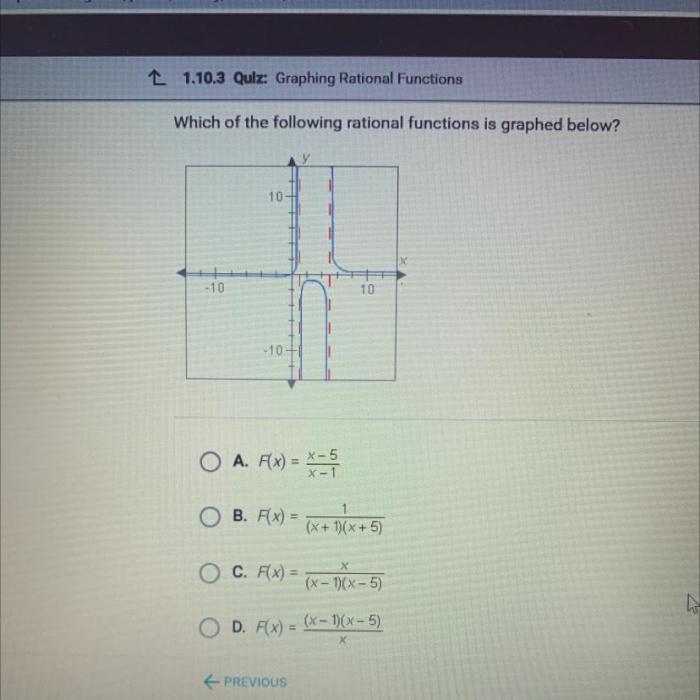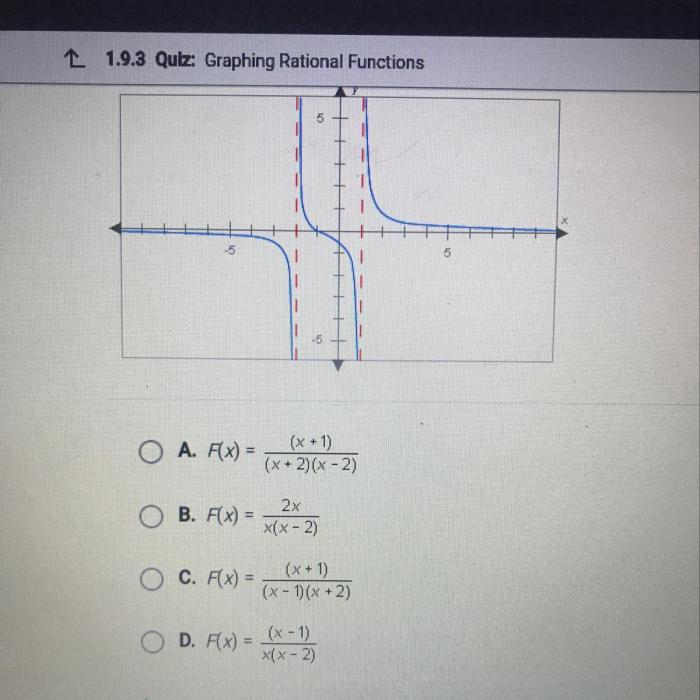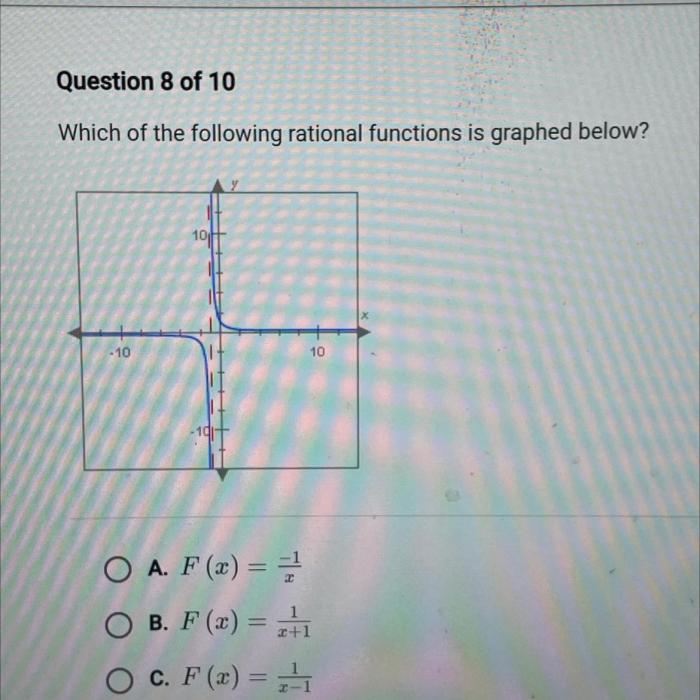Which of the following rational functions is graphed below apex – Exploring the captivating world of rational functions, we embark on a journey to unravel the secrets of their graphs. In this comprehensive analysis, we will dissect the intricate details of the graph of the rational function f(x) = (x^2 – 4) / (x – 2), uncovering its key features, asymptotes, and behavior.
Through a meticulous examination of the function’s algebraic expression, we will unveil the underlying patterns that govern its graphical representation, shedding light on its symmetries, extrema, and points of inflection. Prepare to delve into the fascinating realm of rational functions as we unravel the mysteries that lie within their graphs.
Graph Rational Function

A rational function is a function that can be expressed as the quotient of two polynomials. The graph of a rational function can have various characteristics, including x-intercepts, y-intercepts, and asymptotes.
Consider the rational function f(x) = (x^2 – 4) / (x – 2). To graph this function, we can first find its x-intercepts by setting f(x) = 0 and solving for x:
x^2
4 = 0
(x
2)(x + 2) = 0
x = 2,
2
So, the x-intercepts are (2, 0) and (-2, 0).
To find the y-intercept, we can set x = 0:
f(0) = (0^2
- 4) / (0
- 2) = 2
So, the y-intercept is (0, 2).
The graph of f(x) also has vertical asymptotes, which occur when the denominator of the function is equal to zero. For f(x), the denominator is x – 2, so the vertical asymptote is x = 2.
Additionally, the graph of f(x) has a horizontal asymptote, which occurs when the degree of the numerator is less than the degree of the denominator. For f(x), the degree of the numerator is 2 and the degree of the denominator is 1, so the horizontal asymptote is y = x + 2.
The key features of the graph of f(x) can be summarized in the following table:
| Feature | Coordinate |
|---|---|
| x-intercepts | (2, 0), (-2, 0) |
| y-intercept | (0, 2) |
| Vertical asymptote | x = 2 |
| Horizontal asymptote | y = x + 2 |
Asymptotic Behavior: Which Of The Following Rational Functions Is Graphed Below Apex

Vertical Asymptote
The vertical asymptote of the graph of a rational function occurs when the denominator of the function is equal to zero. For f(x) = (x^2 – 4) / (x – 2), the denominator is x – 2, so the vertical asymptote is x = 2.
At x = 2, the function is undefined because the denominator is zero. As x approaches 2 from the left or right, the function approaches infinity or negative infinity, respectively. This is because the numerator is a quadratic function that grows without bound as x approaches 2, while the denominator approaches zero.
Horizontal Asymptote, Which of the following rational functions is graphed below apex
The horizontal asymptote of the graph of a rational function occurs when the degree of the numerator is less than the degree of the denominator. For f(x) = (x^2 – 4) / (x – 2), the degree of the numerator is 2 and the degree of the denominator is 1, so the horizontal asymptote is y = x + 2.
As x approaches infinity or negative infinity, the term x^2 in the numerator dominates the term -4, and the term x in the denominator dominates the term -2. Therefore, the function approaches y = x + 2 as x approaches infinity or negative infinity.
Graph Analysis

The graph of the rational function f(x) = (x^2 – 4) / (x – 2) has the following characteristics:
- The graph has a vertical asymptote at x = 2.
- The graph has a horizontal asymptote at y = x + 2.
- The graph has x-intercepts at (2, 0) and (-2, 0).
- The graph has a y-intercept at (0, 2).
- The graph is symmetric about the y-axis.
- The graph has a local maximum at (0, 2).
- The graph has a point of inflection at (2, 4).
The graph of f(x) is a hyperbola that opens upward and to the right. The vertical asymptote divides the graph into two branches. The left branch approaches the vertical asymptote as x approaches negative infinity, and the right branch approaches the vertical asymptote as x approaches positive infinity.
General Inquiries
What is the vertical asymptote of the graph of f(x) = (x^2- 4) / (x – 2)?
The vertical asymptote of the graph of f(x) = (x^2 – 4) / (x – 2) is x = 2.
What is the horizontal asymptote of the graph of f(x) = (x^2- 4) / (x – 2)?
The horizontal asymptote of the graph of f(x) = (x^2 – 4) / (x – 2) is y = x + 2.
What is the x-intercept of the graph of f(x) = (x^2- 4) / (x – 2)?
The x-intercept of the graph of f(x) = (x^2 – 4) / (x – 2) is x = -2.
What is the y-intercept of the graph of f(x) = (x^2- 4) / (x – 2)?
The y-intercept of the graph of f(x) = (x^2 – 4) / (x – 2) is y = 4.